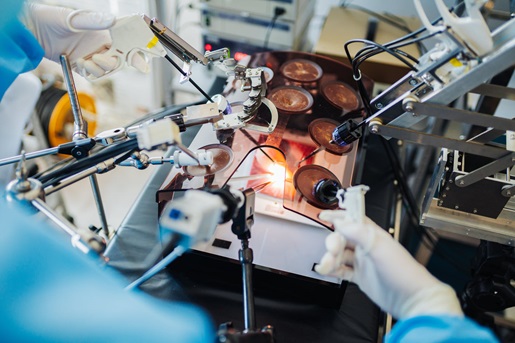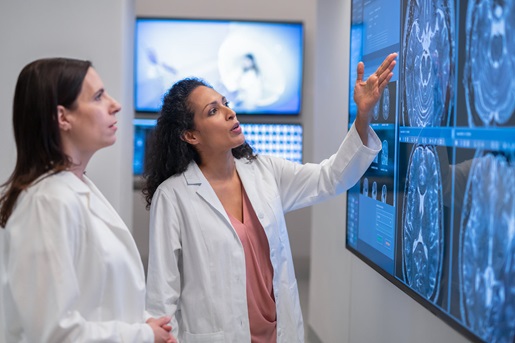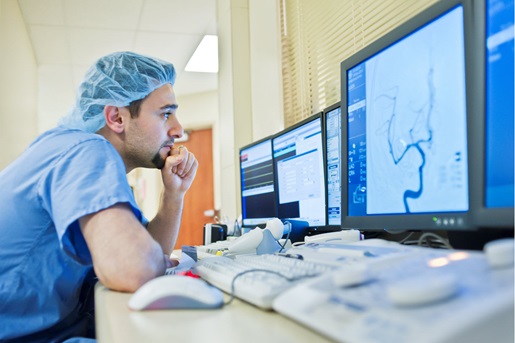The rapidly developing world of artificial intelligence could bring major efficiency gains for healthcare providers
Artificial intelligence may be the defining technology of our time. Every industry on the planet seems interested in taking it for a spin. Why? Because the potential benefits are massive — especially in healthcare. Here, the challenges are complex and the stakes are life and death. Patients need high-quality care, and they need it fast. AI may make both easier to achieve.
But what is AI in healthcare? How does this revolutionary tech work? And how can providers and patients use it to improve their experiences?
Need help picking the right scanner for your transition to AI-powered healthcare? Check out our post, AI in Healthcare: The Complete Guide.
What is AI?
John McCarthy, who coined the term “artificial intelligence” as far back as 1956, defined the concept as “the science and engineering of making intelligent machines.” Although this description can stir our imaginations to picture androids and sentient disembodied voices, reality is far less fantastical. Today, “intelligent machines” are generally computer systems that can perceive their environments in one way or another and can then react accordingly.
For example, AI can be trained to identify patterns in images. That leads to one of the key use cases for AI technology in healthcare. Bots trained on images of brain scans, X-rays, and other key diagnostic tools can identify irregularities. They can do this even faster than humans. They can then flag these irregularities for clinicians to inspect, potentially leading to faster and more accurate diagnoses.
Types of AI technology
There are lots of lofty ambitions for AI technology in healthcare and other sectors. Super AI, for example, would mean creating a sci-fi-style, smarter-than-human robot. All the technology we call AI today falls either into the category of Reactive Machine AI (RMAI) or Limited Memory AI (LMAI).
Reactive Machine AI
Reactive Machine AI bots are designed for very specific tasks. Designers feed them a huge amount of data; the bots then use that data to produce an output with the greatest chance of success. RMAI’s main limitation is that it can’t learn over time. It’s incapable of examining its own decision history, so it can’t get better as it operates.
One famous example of RMAI is Deep Blue, the chess-playing AI. When it beat Garry Kasparov in 1997, it did so by analyzing the pieces on the board each turn. It compared every possible move of every possible piece. It determined the most likely response from Kasparov to each, then chose the move that gave it the highest chance of winning.
Limited Memory AI
Limited Memory AI can recall past events and outcomes — as long as their scope is limited. LMAI can adapt to new demands and improve over time, but only with regard to a specific object or situation. LMAI can only hold its past data for a short time.
Generative AI such as ChatGPT is one of the most popular LMAI implementations. When a user submits a prompt, the AI can take in that new data and adjust its output accordingly. It uses LMAI to predict each word it’s going to write in response. Self-driving cars also use LMAI to interpret obstacles in their path and make real-time decisions about how to react.
Did You Know?:TMC named the RICOH fi-8170 as a Future of Work Product of the Year. TMC recognizes "companies that showcase the most innovative and disruptive products and solutions that have positively supported hybrid work experiences across the globe." Click here to learn more.
AI applications in healthcare
Now that we’ve answered, “What is AI?,” let’s turn to “What is AI in healthcare?” This technology has far-reaching implications for the healthcare sector, from accelerated admin work to fraud protection.
Note Taking
One key to successful care is creating strong bonds between patients and providers. For patients, feeling heard and understood can put them at ease. For providers, careful listening leads to better outcomes. But when providers split their attention between a patient and note taking efforts, they can leave the patient feeling ignored. It’s hard to be personable while taking detailed notes about what’s being said.
AI can help by automatically transcribing conversations between patients and providers. That leads to higher-quality, more complete notes without affecting the clinician’s bedside manner. It also makes reviewing those notes faster and easier. AI can highlight key sections and populate notes out to the patient’s electronic health record (EHR) after the clinician reviews them.
Administrative work
Treating patients requires a lot of administrative work. Every patient must be processed. The key points of their visit must be recorded and added to their electronic health record (EHR). Those records must be sorted for easy access. And every minute clinicians spend on that work is time that could be spent with patients.
RMAI can help by recognizing different types of documents and automatically sorting and tagging them. It can also examine forms for key information and populate it to digital records. That makes generating, processing, sorting, and retrieving records and test results faster.
When moving from physical documents to digital, the key to successful RMAI is providing high-quality scans. The more clearly and consistently documents are scanned, the better AI will parse them.
Care availability
Patients often have questions they want answered outside of standard office hours. With staffing already a challenge for many practices, 24-hour support can be hard to guarantee. That can leave patients confused and in the dark.
Those gaps can be filled with the help of generative AI in healthcare. AI chatbots available on a practice’s site can answer simple patient questions at any time of day. These bots could recognize common questions and provide answers that a clinician has pre-approved. More complex questions could trigger a notification for the clinician to respond when they’re back in the office. And all of these interactions could be automatically tied to the patient’s EHR for future reference.
Fraud protection
According to the FBI, medical fraud causes tens of billions of dollars in losses each year. That raises the cost of medical premiums and out-of-pocket expenses for patients. Medical expenses are already a heavy burden, and fraud makes them worse.
What is AI in healthcare doing to solve this problem? It’s training LMAI to recognize unusual patterns in medical payments. If a provider bills for unnecessary procedures, or ones they didn’t perform, AI could help spot it. It could also identify unbundling, in which providers bill for the individual steps in a common procedure rather than the procedure as a whole. It could alert the patient, and provide a place for conversational AI in healthcare to shine. Its ease of use could make it easy to walk patients through their next steps.
Did You Know?:The fi-8170 can scan up to 70 pages per minute and 10,000 pages per day. Click here to learn more.
Our recommendation: fi-8170
Those wondering “What is AI in healthcare?” have a lot to explore. We take great pride in having spent the last 50+ years researching, designing, and developing some of the most advanced and powerful electronics in the world, including our professional grade fi and SP series of scanners.
Built to purpose for the most demanding document handling jobs, fi and SP scanners are capable of processing tens of thousands of pages per day at the highest levels of accuracy. Their intuitive integration capabilities with all existing work suites minimize time-to-value for businesses looking to invest in tools that will pay dividends for years to come.
Preparing your business to take advantage of AI advancements means bringing it into the digital age. A high-powered scanner like the fi-8170 is one of the best ways to do so. Scans from the fi-8170 are crystal clear, making them excellent training materials for AI bots. The fi-8170 also uses AI of its own called optical character recognition (OCR) to turn images into workable text documents. Click here to learn more or shop the rest of our production scanner line.
Note: Information and external links are provided for your convenience and for educational purposes only, and shall not be construed, or relied upon, as legal or financial advice. PFU America, Inc. makes no representations about the contents, features, or specifications on such third-party sites, software, and/or offerings (collectively “Third-Party Offerings”) and shall not be responsible for any loss or damage that may arise from your use of such Third-Party Offerings. Please consult with a licensed professional regarding your specific situation as regulations may be subject to change.









